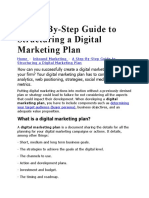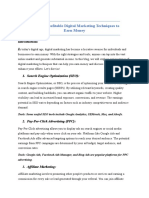G2 Adverti
G2 Adverti
Uploaded by
Nisa GonzalesCopyright:
Available Formats
G2 Adverti
G2 Adverti
Uploaded by
Nisa GonzalesOriginal Title
Copyright
Available Formats
Share this document
Did you find this document useful?
Is this content inappropriate?
Copyright:
Available Formats
G2 Adverti
G2 Adverti
Uploaded by
Nisa GonzalesCopyright:
Available Formats
MEASURING ROI (RETURN OF INVESTMENT)
ROI: Profit earned from investment in marketing or advertising
What is ROI? ROI stands for Return on Investment. The definition of ROI is the total profit
earned from an investment. In terms of Marketing and Advertising, Return on Investment will
look at a total investment into business costs and Marketing campaigns and look at the
return of revenue while factoring in other costs.
It is important to monitor and compare your ROI so you can see how your ads are
performing through Google Ads, Microsoft Advertising, Facebook Ads, Twitter Ads,
LinkedIn Ads, and more. In addition, you can look at your investment into Marketing in
terms of Social Media Marketing, Email Marketing, and Search Engine Optimization
(SEO).
Example: Surfside PPC runs an advertising campaign. I spend 10,000 on advertising,
5,000 on costs, and drive 20,000.
What is my ROI?
ROI = (Revenue - Costs) / Costs x 100%
Revenue: 20,000
Costs: 15,000
ROI = 33.3%
DEVELOPING CONTENT, Ads and COMPREHENSIVE STRATEGY
A content strategy is a plan in which you use content (audio, visual, and/or written) to
achieve your business goals. A successful content strategy will attract your target audience at
every stage of the funnel and keep them engaged even after a purchase.
1. Who will be reading your content?
Just as your business might have more than one type of customer, your content strategy can
cater to more than one type of user.
Using a variety of content types and channels will help you deliver content that's tailored to
each persona.
2. What problem will you be solving for your audience(s)?
A sound content strategy supports people on both sides of your product: those who are still
figuring out what their main challenges are, and those who are already using your product
to overcome these challenges.
3. What makes you unique?
Maybe your main asset is that your company has been established for many years. Or
perhaps you have a unique brand voice that makes you stand out from your competitors.
4. What content formats will you focus on?
Once you identify the best formats, start creating a budget to assess what resources you can
allocate to execute this strategy.
5. What channels will you publish on?
This, again, will reflect where your audience lives. If your audience prefers long-form video
content, you may opt to publish your content on YouTube. If you have a younger audience
that likes quick content, you may opt for TikTok and Instagram.
6. How will you manage content creation and publication?
Today's content strategies prevent clutter by managing content from a topic standpoint.
When planning a content editorial calendar around topics, you can easily visualize your
company's message and assert yourself as an authority in your market over time.
How to Create a Content Strategy Framework
1. Define your goal.
Know your goals before you begin planning, and you'll have an easier time
determining what's best for your strategy.
2. Conduct persona research
If you're an experienced marketer, your target may have changed. Do you want to
target a new group of people or expand your current target market? Do you want to
keep the same target audience? Revisiting your audience parameters by conducting
market research each year is crucial to growing your audience.
3. Run a content audit.
Figure out what you can do differently in the upcoming year and set new goals. Now
is a great time to align your team's goals with the rest of your organization's goals.
4. Choose a content management system.
A few vital parts of content management include content creation, content
publication, and content analytics.
You want to invest in a CMS to create, manage, and track your content in an easy
and sustainable way.
5. Determine which type of content you want to create.
There are a variety of options out there for content you can create, from written
content like e-books and blog posts to audio content like podcasts.
6. Brainstorm content ideas.
it's time to start coming up with ideas for your next content project.
TYING SOCIAL TO BUSINESS GOALS
Use social media to market your business and connect with your customers.
Benefits of social media for business
Social media can help you engage with your customers and find out what people are
saying about your business. You can also use social media for advertising, promotional
giveaways and mobile applications.
Social media can help your business to:
attract customers, get customer feedback and build customer loyalty
increase your market reach, including international markets
do market research and reduce marketing costs
increase revenue by building customer networks and advertising
develop your brand
exchange ideas to improve the way you do business
recruit skilled staff, for example through job networking sites like LinkedIn
increase traffic to your website and improve its search engine ranking
keep an eye on your competitors.
Disadvantages of social media
Social media may not suit every business. If you launch your social media presence
without planning, you could end up wasting valuable time and money.
Disadvantages of social media include:
needing additional resources to manage your online presence
social media is immediate and needs active daily monitoring
you may get unwanted or inappropriate behaviour on your social media site
the risk of getting negative feedback, information leaks or hacking
the risk of having false or misleading claims made on your social media (by
your business or a customer). These claims can be subject to consumer law.
For example, if a customer or fan posts misleading or deceptive information,
particularly about competitor products or services, you might receive a fine.
To avoid the risks, have a social media strategy with policies and procedures
in place before you start.
TRACKING RESULT EASILY
Social Media analytics can help you determine who your audience is and what they
want to see from you. Using tools to track your social media engagement can help
recognize trends that shape strategy.
Because some digital marketing tactics take time to pay off, like SEO, tracking your
results over time will give you better insight into whether your efforts are helping you
reach your goals or whether they’ve stalled out and need to be reworked.
UNDERSTANDING PERFORMANCE ACROSS SOCIAL MEDIA CHANNELS
Social media performance is basically how your page has been performing, the rate of
engagement you’ve received, how much it has been shared, and what kind of progress
you have had. You get to know how your social media performance is and how you can
improve it to do better.
Social media metrics are important because they prove you can measure how successful
a campaign is, how well your social strategy is performing, and ultimately if you will
have an impact on your overall business
You might also like
- Managerial Accounting 16th Edition Garri PDFDocument7 pagesManagerial Accounting 16th Edition Garri PDFSirSikander IqbalNo ratings yet
- SEO Proposal NewDocument15 pagesSEO Proposal NewNaveen Jain50% (2)
- Document04 (Ibis Style)Document3 pagesDocument04 (Ibis Style)SMK BHARA TRIKORA 1 JAKARTANo ratings yet
- Case #2 The US Airline - Group 5Document4 pagesCase #2 The US Airline - Group 5Francesco Uzhu50% (2)
- Digital Marketing Checklist PDFDocument12 pagesDigital Marketing Checklist PDFSHAILESH PURANIK100% (10)
- Digital Marketing in 2023. A Quickstart Guide (Martin Pidsley) (Z-Library)Document101 pagesDigital Marketing in 2023. A Quickstart Guide (Martin Pidsley) (Z-Library)Vlad Vodanovici85% (20)
- SAP S4HANA IFRS15 Compliant Revenue Reporting With SAP RARDocument42 pagesSAP S4HANA IFRS15 Compliant Revenue Reporting With SAP RARSugata Biswas100% (3)
- Finance Theory and Financial StrategyDocument13 pagesFinance Theory and Financial StrategyurgeltaNo ratings yet
- File-4 Notes of CO 2Document17 pagesFile-4 Notes of CO 2charul.mellifluousNo ratings yet
- Efektyvi Rinkodara Soc - MedijojDocument11 pagesEfektyvi Rinkodara Soc - Medijojpedax82223No ratings yet
- Assignment For RTBAnalyticaDocument5 pagesAssignment For RTBAnalyticaPriya OjhaNo ratings yet
- TYBMS 141 Media Planning and ManagementDocument9 pagesTYBMS 141 Media Planning and Managementadee dhumalNo ratings yet
- The Women TalksDocument13 pagesThe Women Talksdorina xhogaNo ratings yet
- Benifits of SMM and StrategyDocument4 pagesBenifits of SMM and StrategyDr-Marria HassanNo ratings yet
- Week 7 - 11 Business Implementation & Marketing Plan, Product Pricing Trategies, Promotion.Document42 pagesWeek 7 - 11 Business Implementation & Marketing Plan, Product Pricing Trategies, Promotion.castillojosephrayNo ratings yet
- Digital Marketing 1Document22 pagesDigital Marketing 1vaishnaviNo ratings yet
- Digital Marketing 1Document22 pagesDigital Marketing 1vaishnaviNo ratings yet
- What Is A Marketing StrategyDocument21 pagesWhat Is A Marketing StrategyIngrid ChaparroNo ratings yet
- Digital Marketin1 Materials AlexDocument10 pagesDigital Marketin1 Materials AlexTEGEGN TEKALIGNNo ratings yet
- Content Marketing Handbook - How To Develop A Content Marketing Strategy That Will Help Your Business GrowFrom EverandContent Marketing Handbook - How To Develop A Content Marketing Strategy That Will Help Your Business GrowNo ratings yet
- DigiMark HandOuts 1..Document5 pagesDigiMark HandOuts 1..Romeo De Guzman Jr.No ratings yet
- DigiMark HandOuts 1Document5 pagesDigiMark HandOuts 1Romeo De Guzman Jr.No ratings yet
- Digital MarketingDocument9 pagesDigital Marketingprasad shevateNo ratings yet
- DSMMDocument25 pagesDSMManushka06No ratings yet
- ProposalDocument8 pagesProposaldorina xhogaNo ratings yet
- E BookDocument54 pagesE Bookriccisantos230No ratings yet
- Social Media Marketing Unit 2Document49 pagesSocial Media Marketing Unit 2Ansh KumarNo ratings yet
- Social Media Marketing For Small Business ThesisDocument5 pagesSocial Media Marketing For Small Business ThesisPaperWritersAlbuquerque100% (2)
- 10 Social Media Lead Generation Ideas For Your Next CampaignDocument53 pages10 Social Media Lead Generation Ideas For Your Next Campaignamitaks2051No ratings yet
- What Is Social Media ManagementDocument5 pagesWhat Is Social Media ManagementAnalia WriterNo ratings yet
- Marketing and FinancingDocument4 pagesMarketing and FinancingPeter John SabasNo ratings yet
- Digital MarketingDocument38 pagesDigital Marketingbuntyyoyo5No ratings yet
- Content MarketingDocument10 pagesContent Marketingk40neerajNo ratings yet
- 10 Tips For Maximizing Your Advertising ReachDocument2 pages10 Tips For Maximizing Your Advertising Reachmithly03No ratings yet
- The Ultimate Guide To Digital Marketing: Strategies and Tactics for SuccessFrom EverandThe Ultimate Guide To Digital Marketing: Strategies and Tactics for SuccessNo ratings yet
- Average Per Post ReachDocument6 pagesAverage Per Post Reachye yintNo ratings yet
- Marketing AssignmentDocument6 pagesMarketing AssignmentHashmi SutariyaNo ratings yet
- An Ultimate Guide To Content Marketing in 2021Document5 pagesAn Ultimate Guide To Content Marketing in 2021Alice EvansNo ratings yet
- How To Leverage Social Media in Your Small Business Marketing Strategy 159627Document5 pagesHow To Leverage Social Media in Your Small Business Marketing Strategy 159627openga.rag.edoors.n.wgaNo ratings yet
- ECOMDocument7 pagesECOMYashana LalwaniNo ratings yet
- What Is Social Media MarketingDocument5 pagesWhat Is Social Media MarketingKHILY SAXENANo ratings yet
- E-Content - Digital Marketing - unit-IVDocument6 pagesE-Content - Digital Marketing - unit-IVkamaltechnolkoNo ratings yet
- A Step by Step GuideDocument8 pagesA Step by Step GuideM. HasanNo ratings yet
- Digital Marketing Part 2 FinalDocument42 pagesDigital Marketing Part 2 Finaltarek.sayd.23d983No ratings yet
- DM Ise Ans QBDocument23 pagesDM Ise Ans QB61COMPCVISHAL YADAVNo ratings yet
- Understanding The Meaning and Significance of Social Media MarketingDocument3 pagesUnderstanding The Meaning and Significance of Social Media Marketingkabirahmad098oNo ratings yet
- Elements of Social Media Campaign & SEMDocument41 pagesElements of Social Media Campaign & SEMAaruni BattaNo ratings yet
- How To Win in Social MediaDocument27 pagesHow To Win in Social MediakunkkonkNo ratings yet
- Social Media MonetizationDocument30 pagesSocial Media Monetizationdorarayan1234No ratings yet
- Digital Marketing Unit 1Document12 pagesDigital Marketing Unit 1kriti PhogaatNo ratings yet
- Digital MarketingDocument15 pagesDigital MarketingRebeca RodasNo ratings yet
- Amna Develop Your Marketing Plan With Useful Tools AmnaDocument9 pagesAmna Develop Your Marketing Plan With Useful Tools AmnaTGS /// AyanNo ratings yet
- Module 6 Abm 323Document11 pagesModule 6 Abm 323mildred aczonNo ratings yet
- Facebook Ads 101 PDFDocument10 pagesFacebook Ads 101 PDFHoussam BelgarchNo ratings yet
- Easy and Profitable Digital Marketing Techniques To Earn MoneyDocument2 pagesEasy and Profitable Digital Marketing Techniques To Earn MoneyMuhammed MughniNo ratings yet
- Unit 1Document12 pagesUnit 1CS0126 VINAY KUMARNo ratings yet
- Tips & Tricks in Digital MarketingDocument31 pagesTips & Tricks in Digital MarketingShyam_Nair_9667No ratings yet
- LeveragingDocument2 pagesLeveragingAnime TimeNo ratings yet
- Week 2 - Type of Marketing Medias Search Campaign StructureDocument55 pagesWeek 2 - Type of Marketing Medias Search Campaign Structurekimaya4546No ratings yet
- Unit 3 MbaDocument11 pagesUnit 3 MbaMiyonNo ratings yet
- Community Management Lesson 1Document47 pagesCommunity Management Lesson 1Varlam TudorNo ratings yet
- Unit 2 Social Media Marketing FinalDocument63 pagesUnit 2 Social Media Marketing FinaltwitterkatoolkitNo ratings yet
- Accounting StandardsDocument26 pagesAccounting StandardsAbhishek Chaturvedi100% (1)
- Financial ModelingDocument4 pagesFinancial ModelingUsha KarkiNo ratings yet
- Gr9 Ag Econ ReportDocument7 pagesGr9 Ag Econ ReportAaron Daniel DuranNo ratings yet
- Advantages of E-Commerce: GeographyDocument6 pagesAdvantages of E-Commerce: GeographyRebecca Fady El-hajjNo ratings yet
- Chapter FourDocument14 pagesChapter FourMuzamel AbdellaNo ratings yet
- Amazon Inventory TechniqueDocument99 pagesAmazon Inventory TechniqueJaya KerupaaNo ratings yet
- CAS 710 Comparative InformationDocument18 pagesCAS 710 Comparative InformationzelcomeiaukNo ratings yet
- MLM's vs. Pyramid SchemesDocument2 pagesMLM's vs. Pyramid SchemesRavi IndianNo ratings yet
- Financial Frauds in IndiaDocument1 pageFinancial Frauds in IndiachaakreeNo ratings yet
- 21EC61 Assignment IDocument1 page21EC61 Assignment IadnagaprasadNo ratings yet
- AP-100S (AP-100Q Answers & Solutions)Document13 pagesAP-100S (AP-100Q Answers & Solutions)Ma. Alyssa PetillaNo ratings yet
- 10 1108 - Yc 05 2023 1749Document21 pages10 1108 - Yc 05 2023 1749Langit BaliageNo ratings yet
- Tendernotice 1Document6 pagesTendernotice 1KaranKikavatNo ratings yet
- Curriculum Vitae Sample Business AdministrationDocument2 pagesCurriculum Vitae Sample Business Administrationezke4pq2100% (2)
- Error CorrectionDocument42 pagesError CorrectionAwang NoviariNo ratings yet
- Presentation 2Document24 pagesPresentation 2ismatarakonikaNo ratings yet
- O o o o o o o O: Citation Needed When?Document12 pagesO o o o o o o O: Citation Needed When?Sunny GoyalNo ratings yet
- Marketing Research 7th Edition Burns Test Bank 1Document25 pagesMarketing Research 7th Edition Burns Test Bank 1angeline100% (64)
- Day 3 SBL Practice To Pass by Hasan Dossani (Dec 2021)Document17 pagesDay 3 SBL Practice To Pass by Hasan Dossani (Dec 2021)Godlove DentuNo ratings yet
- Terminal Sample 2 SolvedDocument11 pagesTerminal Sample 2 SolvedFami FamzNo ratings yet
- 2015 Book ResearchAdvancesInIndustrialEnDocument122 pages2015 Book ResearchAdvancesInIndustrialEnjoseloaizamNo ratings yet
- Optimasi Ekonomi Manajerial S5Document32 pagesOptimasi Ekonomi Manajerial S5RusminNo ratings yet
- Term Paper of Managerial EconomicsDocument4 pagesTerm Paper of Managerial Economicsafmzxhvgfvprhm100% (1)
- 16-1 - Hospital Supply, IncDocument3 pages16-1 - Hospital Supply, IncDiajeng AulyaNo ratings yet
- Corporate Governance in India Law and PracticeDocument56 pagesCorporate Governance in India Law and PracticeShreya TiwariNo ratings yet

























































































